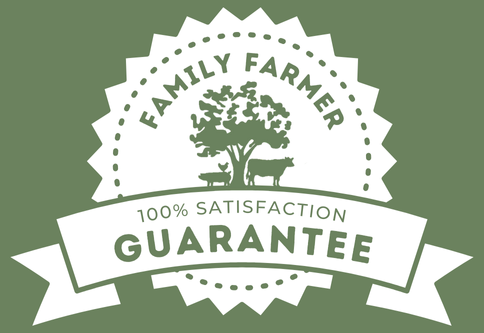The Ultimate Panacea: Regeneratively-Raised Grass-Fed Beef
posted on
February 21, 2025
When people think of reversing climate change, they may associate it with making a lot of sacrifices — ‘doesn't such a feat require much work?’
They then go as far as to entertain the idea of killing off ALL the cows because, ‘cows fart and fart bad for atmosphere 🤓.’
But, what if I told you that you could have your cake and eat it too?
A world where cows can graze green lush pasture (like this one above^^on our farm) whilst putting carbon into its soil — revitalizing our soil and reversing climate change — and where you can enjoy the tastes and not to mention the healing properties and benefits of…
100% regeneratively raised and grass-fed beef (or just ‘super-beef,’ lol). And you get to enjoy it with no shame because, as some say, ‘everybody eats:’ the soil, the cows, your family, etc… all benefiting off of an abundance of essential nutrients and minerals.
Sounds like a WIN-WIN-WIN to me.
So, what exactly are these so-called ‘health-benefits’ that YOU receive? Ok. There’s a lot so, take out your pen and paper.
The magical healing powers 'super-beef' has on your body.
Firstly (1), this ‘super-beef’ contains higher levels of omega-3 fatty acids (some 2-5x the amount of conventional beef), which allows for a more optimal ratio — roughly 1:1 to 1:2 — of omega-3s to omega-6s. Anyone who buys ‘grocery store beef’ likely gets a ratio of around 1:9 — ick.
This might be important to you because a higher concentration of omega-6s are known to cause bodily inflammation, which may lead to numerous diseases/conditions. FYI: You should ideally aim for an omega-3 to omega-6 ratio of 1:1 through 1:4 (remember, our beef is around 1:1-1:2)
Secondly (2), as do all ruminant and pastured animals and their meat, regeneratively-raised grass-fed beef also contains conjugated-linoleic-acid (a type of polyunsaturated fatty acid), or just ‘CLA.’ — which is naturally formed in the rumen (stomach) of cows and other ruminants when they eat fresh pasture.
CLAs get lots of credit for being ‘cancer-fighting,’ and inhibiting tumor growth, as they reduce inflammation and oxidative stress, and prevent cancer cells from spreading…
And people want to say that ‘red meat causes cancer’? Well, if anything, maybe the inflammation-inducing store meat does… especially with that omega-3 to -6 ratio!
Anyways, I digress. I could probably write this whole blog on CLA alone (btw, on average, Americans have less than half the optimal level of CLAs in their diet!)
Thirdly (3), regeneratively-raised grass-fed beef has ELEVATED levels of antioxidants and micronutrients. What this means — one very important aspect — is that you can have a smaller meal yet still receive MORE nutritional benefits than someone eating a larger serving of conventional ‘grocery store beef’.
And you know what? If you take into account the price per amount of nutrients, grass-fed beef may even cost LESS compared to conventional beef (not only does this beef regenerate the land and your health, but your wallet as well ;)).
Anyways, what antioxidants do is help in preventing cell damage, as they neutralize ‘free radicals’ (a type of unstable molecule that is made during normal cell metabolism). This is important because free radicals can build up in cells and cause damage to other molecules — DNA, lipids, and proteins — increasing the risk of disease.
The most prominent antioxidants in our beef include:
- Vitamin E (400% more than conventional beef)
- Glutathione (detoxifies the body, reduces inflammation, and enhances immunity)
- Superoxide Dismutase or 'SOD' (enzymes — which also neutralize free radicals)
And let’s not forget about the ‘micronutrients,’ the backbone of our day-to-day life — supporting energy production, brain function, immune health, and overall well-being…
Most prominently,
- Vitamins like A (beta-carotene) and B (B12, B6, riboflavin, niacin, folate)
- Zinc and Iron (super-bioavailable — which means your body absorbs it EASIER)
- Selenium (reduces oxidative stress and prevents chronic diseases like heart-disease and neurodegenerative disorders)
- Magnesium and Potassium (crucial for energy metabolism; and helps regulate blood pressure and cardiovascular function)
- Choline (improves brain function — regulates memory, mood, muscle memory, etc…)
You’ve probably learned about these in health class, so you already know how crucial it is to get enough in your diet to live optimally.
If you haven't already realized... while everyone else is struggling, playing checkers, you can play chess — considering regenerative grass-fed beef is like a cheat-code to getting all of these essential nutrients in surplus.
Ok, but enough about you and the health benefits you receive. Regeneratively-raised grass-fed beef’s prowess is NOT limited to only that — it also is part of a bigger whole, positively impacting our environment and animals as well (‘positively impacting’ would be an understatement imo).
So not only are you able to eat michelin star tasting beef while taking care of all your nutritional needs — you also are able to impact our environment for the better. So no, you’re not selfish eating ‘this beef’ — you might in fact even feel a deep fulfillment and satisfaction in your soul for your contributions to Earth’s health (not just yours and your families).
How does the practice of regeneratively-raised grass-fed beef nourish our environment?
Reversing the 'biological-age' of our planet Earth.
Firstly (1), and the most important, is the regeneration of nutrients in our soil (which starts a chain reaction of all the other benefits you’ll read about in this blog).
Organic matter in the soil is built up when cattle graze and trample plants and manure into the ground — allowing microbes, fungi, and insects to thrive, increasing soil fertility.
Most importantly, any beneficial microbes (and all the living organic matter) in the soil are NOT ‘killed’ by the use of synthetic fertilizers, pesticides, or herbicides.
This leads to healthy topsoil, which is only enriched with time — the very foundation of a sustainable food system.
(Doesn't that grass look tasty and healthy? ^^^ and that's me and Titus btw :))
Secondly (2), Carbon Sequestration.
Regenerative grazing systems basically turn pastures into carbon sinks — they 'sequester' carbon in the soil (or simply, just sucks it in) — pulling CO2 OUT of the atmosphere, instead of into the atmosphere, by storing it in plant roots and microbes.
This results in capturing more carbon than is released, making properly grazed cattle (like ours) carbon-neutral or even carbon-negative (how’s that for REVERSING climate change 😎).
…As opposed to conventional feedlots (CAFOs) that produce massive methane emissions, contributing to deforestation and soil degradation (due to unnatural diets, overcrowding, manure lagoons, excessive tilling, etc.).
Thirdly (3), Water Conservation.
Do you think the present cattle shortage (which we’ve gone over previously) would have happened without the droughts taking place? — and why did these droughts happen exactly?
Inadequate water retention in the soil.
Well, regenerative grazing radically improves the soil’s ability to retain water — because grass growth is stimulated which then increases ‘soil organic matter,’ (or ‘SOM’). This 'super-soil' can infiltrate up to 20x the amount of water per hour that ‘conventional’ soil can, which means: no more runoff or droughts!
And not to mention, these dense grass-lands filter rainwater naturally, preventing pollution from entering rivers and lakes.
…Ok but, all of this wouldn’t be possible with ONE important benefactor… THE COW.
So, what does the humble cow get in return, to deem it worthwhile to deliver such labors?
Day in the life of our saintly and enlightened cows.
Firstly (1), our cows eat what they are SUPPOSED to — what nature intended.
As we’ve stated previously, cattle are ‘ruminant’ animals; animals whose digestion systems are designed to digest grass, herbs, and other forage — not some GMO-infested ‘grain’ slop (feeding grain to cows is like feeding McDonalds to your toddler — except the fact that the cow probably WON’T enjoy grain).
This natural, high-fiber diet (which may include a variety of grasses, legumes, and wild plants) supports healthy digestion, and a healthy metabolism, eliminating possibilities for disease. Thus eliminating the need for antibiotics (Wanda Farms does not use ANY btw).
As a result, our cows ultimately live longer and healthier lives.
Secondly (2), our cows enjoy ‘better’ living conditions and lower stress levels. Though, ‘better’ would be an understatement — the difference between CAFO feedlots and pastures like ours is night and day.
Imagine this: You slowly open your eyes, as the sun's rays are peeking over the horizon with its dark orange hue. It’s dawn — you hear the sparrows singing through the dark leaves of the woods in the overlooking distance as you slowly rise to get up for the day. The morning dew leaves you slightly chilled — though the sun quickly warms your body up. ‘Time for breakfast,’ you think to yourself, and start savouring the dense hydrating dew-stricken grass below your feet…
Such is a typical summer morning for a cow at Wanda Farms (or any real regenerative farm) — leisure at its finest. Being in a calm, stress-free environment, these cows also deposit more healthy fats (like CLAs and omega-3s), contributing to the marbleness, tenderness and flavor of its meat.
Thirdly (3), our cows get to grow up NATURALLY.
There are no growth hormones (and routine antibiotics) trying to fatten them up alongside a bunch of bloating-causing grains — which only causes problems and disease.
Our cows’ lives are stretched out as far as possible, allowing them to go through all of their stages of life in the way they ought to. We know that the happier and more fulfilled a cow is, the better its meat tastes as a result…
Oh, the oh so humble cow, single handedly leading the human race to collective victory, all whilst feeding you with exceptionally tasting and quality beef that will keep you youthful and strong, for ages and ages, lifelong
How can we repay and give thanks to this divine animal?
Well, other than worshiping it, obviously — as we already do from sunrise to sunset — we can honor The Humble Cow by buying in bulk shares, instead of individually buying cuts of beef (which may be from different cows).
But, if you can’t resist ‘getting a piece of’ such a beautiful creature, and are at the same time not ready for a ‘bulk’ commitment, buying a-la-carte (individual steaks and cuts) is still okay, as you are still supporting the labors from a regenerative grass-fed cow.
Besides, who can resist a steak like this?^^
God Bless,
Joe



